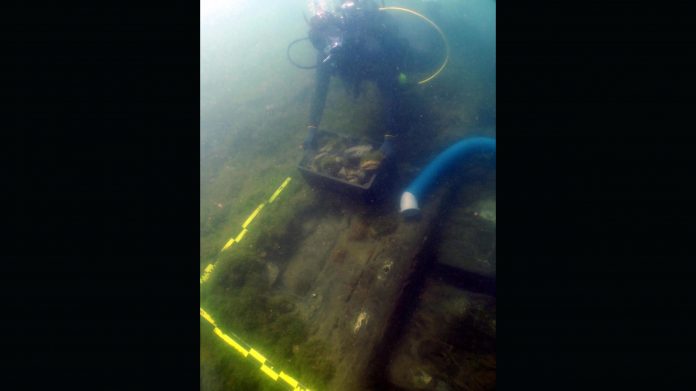
by Gemma Handy
Archaeologists probing the thrilling discovery of an 18th century naval shipwreck in English Harbour are to spend the next few months meticulously laying out plans for the site’s management and protection.
On Friday the team revealed they were a step closer to formally identifying the vast vessel which has lain concealed in mud at the entrance to the Antigua Naval Dockyard, just eight feet below the water’s surface, for more than 200 years.
The 40-metre wooden ship was first glimpsed by local diver Maurice Belgrave some years ago but its presence was only confirmed last month by a team of visiting archaeologists.
They believe it’s the remains of the 1762 Beaumont, a French merchant ship later renamed the Lyon and used in the American Revolution.
Last month’s week-long archaeological dig has added weight to that theory, with its measurements matching the dimensions of the Lyon, said archaeologist Dr Christopher Waters of the National Parks Authority.
“After the initial discovery we had our dive team carry on working on the site, mostly mapping, trying to find the extent of all the timbers, and the scope and size of the site.
“We managed to find what we think is the entirety of the site,” he told Observer.
“Then they did a very small, gentle clean of a part of the keelson to look at the architecture. We got confirmation that we have a solid wooden wreck of incredibly robust construction which illustrates military grade construction from probably the 18th century.
“We are pretty sure it’s the Lyon – or ex-Beaumont – captured by the British in 1778 and brought to English Harbour.”
As a heavily armed merchant ship, the 900-tonne Beaumont was designed to travel from France to the Indian and Pacific oceans.

It was built by the French East India Company, a 17th century imperial commercial enterprise established to compete with English and Dutch trading firms in what is today east Asia.
After serving for two years in the French navy, the Beaumont was bought by a private merchant who renamed it. It played a role in the American Revolution, before being captured by the British off the coast of Virginia.
Historians know the ship was brought to English Harbour but no one knows what happened to it after that. They believe it was so badly damaged it probably never left the island again.
Last month’s investigation was funded by the French government’s Ministry of Europe and Foreign Affairs, the Richard Lounsbery Foundation, and the Overseas Martinique Convergence Contract.
Additional assistance was lent by the University of the French West Indies, ABSAR and the English Harbour-based Soul Immersion dive shop.
The next step is for the team to write a thorough report setting out exactly what they did, before looking at long-term plans for the site and its management.
The vessel’s sheer size means much more funding will be needed for further investigation.
“This is a significantly larger wreck than any of us expected – and the bigger something is, the more energy and funding required to continue the research,” Dr Waters explained.
Protecting the vessel in the meantime is crucial.
“It is in the middle of the harbour and in order to protect the site where it is now, we need to establish safety protocols,” he continued.
“We don’t want snorkellers or divers on it as it can be very dangerous. And, in the future if we want people to be able to visit the site, we need to start developing protocols and procedures.
“Over the next three to six months we will be coming up with new plans and trying to figure out how best to protect and save it,” Dr Waters said.
Dr Waters also spoke about what the incredible find means for the country.
“It really raises the profile of Antigua and Barbuda; it’s something else interesting to hear about, read about and visit.
“If it is the Lyon, it is the only known French East India Company shipwreck with any kind of wooden hull left in the world, which means it’s really interesting for researchers looking into maritime architecture,” he added.
